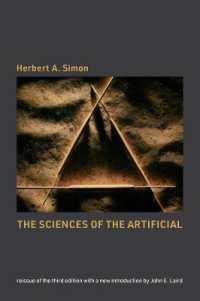- ホーム
- > 洋書
- > 英文書
- > Architecture
Full Description
In Mallparks, Michael T. Friedman observes that as cathedrals represented power relations in medieval towns and skyscrapers epitomized those within industrial cities, sports stadiums exemplify urban American consumption at the turn of the twenty-first century. Grounded in Henri Lefebvre and George Ritzer's spatial theories in their analyses of consumption spaces, Mallparks examines how the designers of this generation of baseball stadiums follow the principles of theme park and shopping mall design to create highly effective and efficient consumption sites.
In his exploration of these contemporary cathedrals of sport and consumption, Friedman discusses the history of stadium design, the amenities and aesthetics of stadium spaces, and the intentions and conceptions of architects, team officials, and civic leaders. He grounds his analysis in case studies of Oriole Park at Camden Yards in Baltimore; Fenway Park in Boston; Dodger Stadium in Los Angeles; Nationals Park in Washington, DC; Target Field in Minneapolis; and Truist Park in Atlanta.
Contents
Cathedrals OF Consumption
1. Leading Off
2. Producing Consumption Space
The Spatial Practices of Baseball Stadiums
3. Grounds, Ballparks, and Superstadiums
4. The Spatial Practices of the Mallpark
Conceiving Mallparks
5. Camden Yards: Forever Changing Baseball
6. Fenway Park and Dodger Stadium: The Camdenization of a Ballpark and a Superstadium
7. Nationals Park: A Mallpark of Magnificent Intentions
8. Target Field: Different in the Same Way
The Future of Baseball Stadium Design
9. Truist Park: Supercharging the Mallpark
10. Making Baseball Great Again






